mindspore.nn.GELU
- class mindspore.nn.GELU(approximate=True)[源代码]
高斯误差线性单元激活函数(Gaussian error linear unit activation function)。
对输入的每个元素计算GELU,输入可以是任意有效shape的Tensor。
GELU的定义如下:
其中
GELU函数图:

- 参数:
approximate (bool,可选) - 是否启用approximation。默认值:
True。如果approximate的值为True,则高斯误差线性激活函数为:否则为:
说明
在计算gelu的输入梯度时,当输入为inf,Ascend与GPU在反向传播输出之间存在差异。
当输入x为-inf时,Ascend的计算结果为0,GPU的计算结果为nan。
当输入x为inf时,Ascend的计算结果为梯度dy,GPU的计算结果为nan。
数学意义上,Ascend的计算结果精度更高。
- 输入:
x (Tensor) - 用于计算GELU的Tensor。数据类型为float16、float32或float64。shape是
- 输出:
Tensor,具有与 x 相同的数据类型和shape。
- 异常:
TypeError - x 的数据类型不是float16、float32或float64。
- 支持平台:
AscendGPUCPU
样例:
>>> import mindspore >>> from mindspore import Tensor, nn >>> import numpy as np >>> x = Tensor(np.array([[-1.0, 4.0, -8.0], [2.0, -5.0, 9.0]]), mindspore.float32) >>> gelu = nn.GELU() >>> output = gelu(x) >>> print(output) [[-1.5880802e-01 3.9999299e+00 -3.1077917e-21] [ 1.9545976e+00 -2.2918017e-07 9.0000000e+00]] >>> gelu = nn.GELU(approximate=False) >>> # CPU not support "approximate=False", using "approximate=True" instead >>> output = gelu(x) >>> print(output) [[-1.5865526e-01 3.9998732e+00 -0.0000000e+00] [ 1.9544997e+00 -1.4901161e-06 9.0000000e+00]]